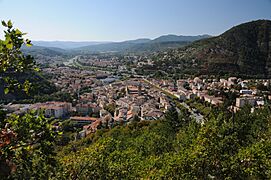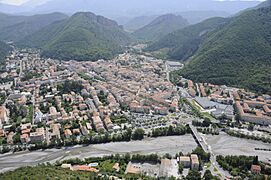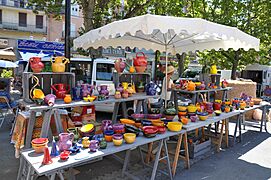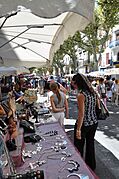Digne-les-Bains facts for kids
Quick facts for kids
Digne-les-Bains
Dinha dei Banhs (Occitan)
|
||
|---|---|---|
|
Prefecture and commune
|
||

A view of Digne-les-Bains
|
||
|
||
| Country | France | |
| Region | Provence-Alpes-Côte d'Azur | |
| Department | Alpes-de-Haute-Provence | |
| Arrondissement | Digne-les-Bains | |
| Canton | Digne-les-Bains-1 and 2 | |
| Intercommunality | Provence-Alpes Agglomération | |
| Area
1
|
117.07 km2 (45.20 sq mi) | |
| Population
(2021)
|
17,192 | |
| • Density | 146.852/km2 (380.346/sq mi) | |
| Time zone | UTC+01:00 (CET) | |
| • Summer (DST) | UTC+02:00 (CEST) | |
| INSEE/Postal code |
04070 /04000
|
|
| Elevation | 524–1,731 m (1,719–5,679 ft) (avg. 608 m or 1,995 ft) |
|
| 1 French Land Register data, which excludes lakes, ponds, glaciers > 1 km2 (0.386 sq mi or 247 acres) and river estuaries. | ||
Digne-les-Bains is a city in southeastern France. It's the main city, or "prefecture," of the Alpes-de-Haute-Provence department. The city is often just called Digne.
About 17,000 people live here. Digne-les-Bains is known for its warm, healing waters, which people have used for a very long time.
Contents
Geography of Digne-les-Bains
Where Digne-les-Bains is Located
Digne-les-Bains sits at the edge of the Digne Prealps, which are foothills of the Alps mountains. The Bléone river flows through the city.
The city center is about 608 meters (nearly 2,000 feet) above sea level. Digne-les-Bains is the capital of its department, but it's one of the smaller capitals in France by population.
The old part of Digne is built on a hill between the Bléone river and a stream with hot springs. The city has grown over time, spreading out along the valleys. It's located on a special geological thrust fault, which is like a big crack in the Earth's crust where rocks have been pushed over each other.
- Views of Digne-les-Bains
Nearby Towns
Digne-les-Bains is surrounded by several other towns. These include La Robine-sur-Galabre, Le Brusquet, Marcoux, Archail, Tartonne, Clumanc, Chaudon-Norante, Châteauredon, Le Chaffaut-Saint-Jurson, Aiglun, Champtercier, and Thoard.
 |
 |
|||
Climate in Digne-les-Bains
Digne-les-Bains has a climate that is warm and humid, but it also has influences from the Mediterranean and oceanic climates. Summers are hot and quite dry, while winters are cool and a bit wet. It often freezes in the winter months.
| Climate data for Digne-les-Bains, Alpes-de-Haute-Provence (altitude:610m, 2013-2024 normals and extremes) | |||||||||||||
|---|---|---|---|---|---|---|---|---|---|---|---|---|---|
| Month | Jan | Feb | Mar | Apr | May | Jun | Jul | Aug | Sep | Oct | Nov | Dec | Year |
| Record high °C (°F) | 19.1 (66.4) |
23.2 (73.8) |
24.0 (75.2) |
27.3 (81.1) |
32.6 (90.7) |
40.1 (104.2) |
35.1 (95.2) |
36.9 (98.4) |
32.2 (90.0) |
27.7 (81.9) |
22.7 (72.9) |
19.0 (66.2) |
40.1 (104.2) |
| Mean daily maximum °C (°F) | 9.7 (49.5) |
12.1 (53.8) |
14.7 (58.5) |
17.5 (63.5) |
21.0 (69.8) |
26.1 (79.0) |
29.7 (85.5) |
29.1 (84.4) |
24.2 (75.6) |
19.7 (67.5) |
13.3 (55.9) |
10.4 (50.7) |
19.0 (66.1) |
| Daily mean °C (°F) | 4.3 (39.7) |
6.1 (43.0) |
8.4 (47.1) |
11.2 (52.2) |
14.8 (58.6) |
19.6 (67.3) |
22.5 (72.5) |
21.8 (71.2) |
17.7 (63.9) |
13.7 (56.7) |
8.1 (46.6) |
5.1 (41.2) |
12.8 (55.0) |
| Mean daily minimum °C (°F) | −1.2 (29.8) |
0.1 (32.2) |
2.0 (35.6) |
4.9 (40.8) |
8.6 (47.5) |
13.1 (55.6) |
15.3 (59.5) |
14.7 (58.5) |
11.2 (52.2) |
7.8 (46.0) |
2.8 (37.0) |
−0.1 (31.8) |
6.6 (43.9) |
| Record low °C (°F) | −10.8 (12.6) |
−7.4 (18.7) |
−4.8 (23.4) |
−3.8 (25.2) |
0.2 (32.4) |
6.3 (43.3) |
6.9 (44.4) |
7.4 (45.3) |
0.4 (32.7) |
−0.3 (31.5) |
−6.1 (21.0) |
−10.1 (13.8) |
−10.8 (12.6) |
| Average precipitation mm (inches) | 40.3 (1.59) |
47.6 (1.87) |
52.3 (2.06) |
59.9 (2.36) |
78.5 (3.09) |
80.4 (3.17) |
26.7 (1.05) |
39.6 (1.56) |
62.1 (2.44) |
87.1 (3.43) |
78.0 (3.07) |
68.7 (2.70) |
694.9 (27.36) |
| Average precipitation days (≥ 1.0 mm) | 5.7 | 6.1 | 5.5 | 6.8 | 9.5 | 6.8 | 4.1 | 4.1 | 5.2 | 7.7 | 7.9 | 7.4 | 76.8 |
| Mean monthly sunshine hours | 128.7 | 131.8 | 173.9 | 169.1 | 196.8 | 226.4 | 272.6 | 236.4 | 189.4 | 157.4 | 108.7 | 117.9 | 2,109.1 |
| Source: Infoclimat | |||||||||||||
Geology and Landscape
Digne-les-Bains is famous for its geology. The town is built near a "cluse," which is a narrow valley cut through mountains by a river. The hot springs get their healing powers from rising through special rock layers.
The highest mountain in the area is Le Cousson, at 1,516 meters (about 4,974 feet). Another peak, Bigué, is 1,653 meters (about 5,423 feet) high.
Many hills and rocks around Digne are great for hiking. Some popular spots include:
- The Rocher de Neuf Heures (Rock of Nine o'clock)
- Three chapels: Our Lady of Lourdes, Saint-Vincent, and La Croix
- Trails along the Bléone river and up to the crests of nearby hills.
Ammonite Slab: A Geological Treasure
The 'Ammonite Slab of Digne-les-Bains' is a world-famous geological site. It's a huge rock surface with over 1,500 fossils of ammonites, which are ancient sea creatures similar to squids, but with spiral shells. Some of these fossils are as big as 70 centimeters (about 27 inches) across!
This slab is about 200 million years old. In 2022, the International Union of Geological Sciences (IUGS) named it one of the top 100 'geological heritage sites' in the world. This means it's a very important place for understanding Earth's history.
Waterways
The Eaux-Chaudes Valley has one cold spring and eight hot springs. These hot springs are used for hydrotherapy, which is a type of treatment using water. Some of these springs contain minerals like sulfur and arsenic, which are believed to have healing properties.
The city is also crossed by the Bléone and Mardaric rivers.
Transportation
Roads
Digne-les-Bains is connected by the N85 road.
| N85 Route nationale 85 | ||
| Towards the Mediterranean Sea | Towards Grenoble | |
|---|---|---|
| Barrême | Digne-les-Bains | Mallemoisson |
Trains
The city has a special narrow-gauge railway line called the Train des Pignes (Pine Cone Train). It connects Digne to Nice and runs daily, serving many small places along the way.
Buses
Since 1992, Digne has its own public bus system called TUD (Urban Transport Digne). There are six bus routes that help people get around the city.
Natural Risks
Digne-les-Bains is in an area with some natural risks. These include:
- Earthquakes: The area has experienced earthquakes in the past.
- Forest fires: Especially during dry seasons.
- Flooding: The Bléone river and its smaller streams can flood.
- Landslides: Parts of the area are at risk of ground moving.
The city has plans in place to help prepare for and manage these risks.
Nearby Villages that Joined Digne
Over time, Digne-les-Bains has grown by including nearby villages:
- Courbons: Joined Digne in 1862. It was a small village with a church from the 12th century.
- Les Dourbes: Joined Digne in 1974. It had a small castle built in the 11th century.
- Gaubert: Joined Digne in 1862. Its church dates back to the 12th century.
- Les Sieyes: Joined Digne in 1862. It had two old churches.
History of Digne-les-Bains
Ancient Times
People have lived in the Digne area since the Neolithic age (New Stone Age). The three rivers made it a good place to settle. Before the Romans arrived, it was the main town for a group of people called the Bodiontici.
The Romans later built a town here called Dinia in the 1st century AD. It was a busy trading stop. By 780 AD, it was known as Digna and was liked for its warm springs.
Middle Ages
In the Middle Ages, Digne had two separate parts: the town and the city. The city part grew around a castle built on a rock by the bishop. These two parts worked independently until 1385, when they joined together under one administration.
Early Modern Era
Like much of France, Digne was affected by the French Wars of Religion in the 16th century. In 1562, Protestants damaged the cathedral. The city was attacked several times during these wars.
In 1589, a group called the Catholic League took control of the town. In 1591, the Royal army took it back. During this time, people even destroyed the bishop's castle to stop it from being used by either side.
French Revolution and Napoleon
When news of the storming of the Bastille (a big event in the French Revolution) reached Digne in 1789, people were excited for change. There was also a "Great Fear" where rumors of armed groups caused panic.
Digne became the capital of its department in 1790. A "patriotic society" was formed, which supported the Revolution.
In March 1815, Napoleon Bonaparte passed through Digne-les-Bains. He was on his way from being exiled on the island of Elba and was gathering support to try and regain power. This period is known as his Hundred Days, which ended with his defeat at the Battle of Waterloo.
Recent History
In 1851, a political event called a "coup d'état" happened in France. This caused people in Digne to set up their own temporary government.
Digne-les-Bains was one of the first towns to have schools, even before laws made it mandatory for all towns. By the 1860s, Digne had schools for both boys and girls.
World War I
During World War I, 210 people from Digne died fighting for France. The local hospital cared for injured soldiers, and many who died from their injuries are buried in the military cemetery.
World War II
During World War II, Digne was first occupied by Italy, then by the German army. Thirty-four Jewish people were arrested in Digne and taken away.
On August 16, 1944, the city was bombed by American planes. They were trying to hit a bridge, but some bombs also damaged buildings and killed civilians. The city was freed on August 19, 1944, by American and French Resistance forces.
After 1945
In 1974, the nearby village of Dourbes became part of Digne. In 1988, the town officially changed its name to Digne-les-Bains. The city continues to grow, especially along the Bléone river.
On March 24, 2015, Germanwings Flight 9525 crashed a few miles from Digne-les-Bains. All 150 people on board died.
Population and Community
Population Growth
| Historical population | ||
|---|---|---|
| Year | Pop. | ±% p.a. |
| 1968 | 14,722 | — |
| 1975 | 15,416 | +0.66% |
| 1982 | 15,149 | −0.25% |
| 1990 | 16,087 | +0.75% |
| 1999 | 16,064 | −0.02% |
| 2007 | 17,455 | +1.04% |
| 2012 | 16,844 | −0.71% |
| 2017 | 16,460 | −0.46% |
| Source: INSEE | ||
In 2006, Digne-les-Bains started a project to build more homes. The goal was to increase the population to over 20,000 people, which would help the city get more public funding.
City Size and Population Rank
Digne-les-Bains covers an area of 117.07 square kilometers (about 45 square miles) and has a population of 17,268 people. Here's how it ranks compared to other places:
| Rank | Population | Area | Density |
|---|---|---|---|
| France | 553rd | 147th | 5,414th |
| Provence-Alpes-Côte d'Azur | 43rd | 19th | 220th |
| Alpes-de-Haute-Provence | 2nd | 8th | 6th |
| Arrondissement of Digne-les-Bains | 1st | 3rd | 2nd |
Education in Digne-les-Bains
As the main city of the department, Digne-les-Bains has many important schools:
- Fourteen schools, including primary and nursery schools.
- Two middle schools (collèges), Maria-Borrely and Pierre-Gassendi.
- Three high schools (lycées), including vocational and general schools.
- A University Institute of Technology (IUT), where students can study subjects like environmental engineering and business tourism.
- A Graduate School of Teaching and Education (ESPE) for future teachers.
Sports in Digne-les-Bains
In 2006, Digne-les-Bains was named the "Sportiest town in France" for cities with fewer than 20,000 people by a French newspaper.
The city has many sports facilities, including:
- Gyms
- A stadium
- An equestrian (horse riding) center
- A golf course
- A public swimming pool
It's also one of the few French towns that offers free access to tennis courts. A skatepark has been updated for everyone to enjoy.
Religion
Digne-les-Bains is the seat of the Catholic bishopric for the department. This means it's where the main Catholic bishop lives and works. Catholics have two churches for Mass: Notre-Dame-du-Bourg and Saint-Jérôme. There are also places of worship for Muslims and Protestants.
Economy
Jobs and Businesses
In 2017, about 6,422 people in Digne-les-Bains had jobs, with most of them working within the city.
Agriculture
Farming is still important in the area. There are 37 professional farms, mostly raising sheep and cattle. The land used for farming has grown over the years.
Digne-les-Bains also has olive groves that produce olive oil with a special quality label called AOC.
Industry and Shops
Digne-les-Bains has various businesses, including:
- Companies in construction and manufacturing.
- Two weekly markets where you can find local products, crafts, and olives.
- The market in Digne-les-Bains
Services
The service sector, which includes shops, healthcare, education, and administrative jobs, is a big employer in Digne-les-Bains. Many people work in these areas.
Some large employers in the city include:
- Chemins de Fer de Provence (the railway company)
- SAMSE (a building materials dealer)
- Supermarkets like Carrefour and Intermarché
- Orange (a telecommunications company)
- Banks like Groupe Caisse d'Épargne and the Banque de France
- The Renault car dealership
Tourism
Tourism is an important part of Digne-les-Bains' economy. The city has many places for visitors to stay, including hotels, campsites, and apartments.
Thermal Baths
The city's thermal baths are a major attraction. They use hot springs that are 50°C (122°F) and are used to treat breathing problems and rheumatism (joint pain). Many people visit the baths, staying for thousands of nights each year. The spa also has a "Zen Space and Fitness" area with massages and a warm thermal pool.
- Hydrotherapy in Digne-les-Bains
Local Culture and Heritage
Places to Visit
The Dalle à ammonites (Ammonite Slab) is a must-see. It's a huge rock with over 1,500 ancient ammonite fossils, some as big as 70 cm (27 inches) across!
Churches and Religious Buildings
Digne-les-Bains has a rich religious history with several important buildings:
- The Cathedral Notre-Dame-du-Bourg is a very old Romanesque cathedral. Its foundations date back to the 9th century. Inside, you can see parts from the 11th and 12th centuries, and a white marble altar from the Merovingian era (a very early French kingdom).
- Underneath this cathedral, there's an archaeological crypt. Here, you can see ancient walls from the 1st century AD and learn about the city's beginnings and early Christian buildings.
- The Saint-Jérôme Cathedral is a Gothic cathedral built in the 15th and 16th centuries. Its front was added in the 19th century.
- Cathedrals in Digne-les-Bains
- The Notre-Dame-de-Lourdes Church was built in 1870 and is known for its large brick walls.
- The Chapel of Saint-Vincent is still in good condition, while the nearby Chapel of the Cross is slowly falling into ruin.
- Many churches are also found in the villages that joined Digne, like Notre-Dame-des-Anges in Courbons and Saint-Genest in Dourbes.
Other Buildings and Monuments
- You can still see parts of the old city walls and towers from the 14th century around the older parts of Digne.
- The Hotel Thoron de la Robine is a historic building from the 17th century.
- The Fountain from 1829 is a recognized historical monument.
- The city also has many sculptures. From 1983 to 1991, Digne hosted an international sculpture event, and many of the winning works, made of Carrara marble, are now displayed in public spaces.
Museums and Culture
- The Museum of the Haute-Provence Geological Reserve is a great place to learn about the area's unique geology. It also has a butterfly garden.
- The Gassendi Museum mixes art and science, showing how they connect through history. It has an archaeology section that started in 1889.
- The Museum of the Second World War has documents and items from that time, showing Digne's role in the war.
- The Museum of Alexandra David-Néel is located in her former home. She was a famous Belgian-French writer and explorer who lived in Digne.
- The Botanic Garden of Les Cordeliers is a lovely place to see different plants.
Festivals and Events
Lavender Corso
Digne celebrates lavender, a symbol of the region, every year on the first weekend of August with the Corso of lavender. This fun event includes:
- A funfair
- A fireworks display
- A parade with floats decorated with lavender and crepe paper
- 500 musicians and dancers from different countries
The Corso attracts 10,000 to 15,000 people each day!
- The Corso of Lavender, in August
Urban Culture and Music Festival
Since 2002, Digne has hosted an annual festival of urban culture and music in May. This festival aims to share urban arts like graffiti, slam, street basketball, hip-hop dance, and skateboarding. It also features contemporary music like rap, rock, pop, and electro. The event includes sports tournaments and open stages for performers.
Film Festival
Every spring, the René-Char cultural center hosts the Festival les Rencontres cinématographiques de Digne. This film festival brings together cinema professionals and shows art and experimental films.
Sports Competitions
- The Raid des Terres Noires (Raid of the Black Lands) is a popular mountain biking event held every year since 2004, attracting over a thousand participants.
- Raid of the Black Lands
- The Enduro of the Black Lands is another mountain biking event that started in 2013.
- The Half-marathon of the Ammonites is a running race that connects the village of Barles to Digne. It goes through beautiful parts of the Haute-Provence Geological Reserve, passing famous sites like the Ammonite Slab.
- The Trail of Cousson is a race walking event with different courses through the geological reserve, forests, and villages. It also includes fun races and activities for children.
City Symbols (Heraldry)
| The arms of Digne-les-Bains are: "Azure to a fleur-de-lis of Or accompanied at head by a cross of gules, at flanks with two "L" letters capitalised faced Argent and in point of a letter "D" capitalised also of Or"
|
The city's coat of arms (its symbol) shows a gold fleur-de-lis (a lily symbol), a red cross, two capital "L" letters, and a capital "D".
- The cross represents the bishopric (the area managed by the bishop).
- The fleur-de-lis symbolizes the Counts of Provence.
- The letter "D" stands for Digne.
- The "L" letters were added later, possibly during the time of King Louis XIV.
Notable People from Digne-les-Bains

Many interesting people have connections to Digne-les-Bains:
Important Figures and Religious Leaders
- Saint Domnin (died 379 AD) and Saint Vincent of Digne: The first two Bishops of Digne.
- Douceline of Digne (1214–1274): She started a group of women called the Beguines in Marseilles, who helped the poor and sick.
- Pierre Gassendi (1592–1655): A famous philosopher, priest, astronomer, and mathematician.
- Bienvenu de Miollis (1753–1843): A kind Bishop of Digne from 1805 to 1838, who inspired a character in the famous book Les Misérables.
- Jean-Louis Bianco (born 1943): A politician who was once the mayor of Digne.
Artists and Writers

- Alexandra David-Néel (1868–1969): A Belgian-French writer, spiritualist, and explorer who lived in Digne from 1928.
- Louis Botinelly (1883–1962): A French sculptor.
- Jean Daviot (born 1962): A French contemporary artist.
- Cyril Féraud (born 1985): A journalist and television presenter.
Scientists
- Alphonse Beau de Rochas (1815–1893): An engineer who patented the four-stroke engine in 1862, which is used in many cars today.
- Sébastien Point (born 1982): A physicist and researcher.
Sports Figures
- Alain Boghossian (born 1970): A famous footballer who played for France.
- Antoine Méo (born 1984): A multiple world champion in motocross Enduro.
- kennyS (born 1995): Real name Kenny Schrub, a professional video game player in Counter-Strike: Global Offensive.
See also
 In Spanish: Digne-les-Bains para niños
In Spanish: Digne-les-Bains para niños





























